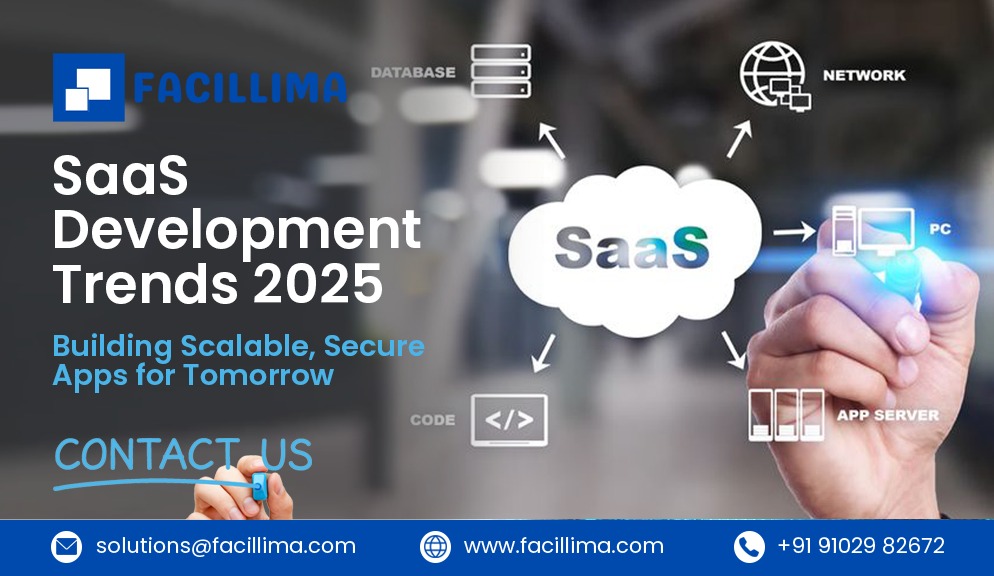
In a fast-changing technological landscape, knowing the SaaS development trends is not just an advantage—you are going to need to be first as a matter of survival.
 At Facillima, countless software solutions have been created obsolete and adjusted to changing market demands. Let’s dive into the innovative SaaS development trends in 2025 with Facillima.
At Facillima, countless software solutions have been created obsolete and adjusted to changing market demands. Let’s dive into the innovative SaaS development trends in 2025 with Facillima.
In today’s rapidly evolving tech ecosystem, staying ahead in SaaS development is not optional—it’s essential for survival. As we move through 2025, businesses are no longer just looking for software that works—they demand scalable, secure, and future-ready solutions. At Facillima, we’ve seen how fast-changing market dynamics can render once-cutting-edge software obsolete.
That’s why we’re committed to building intelligent SaaS applications that not only keep up but lead the way. With a sharp focus on agility, cloud-native architecture, AI integration, and cybersecurity, we’re helping businesses adapt and thrive in a digital-first world. This year, SaaS is not just a service model—it’s a growth engine
The Shift to Microservices Architecture
Remember when monolithic applications were the standard? Those days are long gone. We are observing a clear movement to microservices architecture across the industry, which is justified. One of our healthcare clients just recently switched from a monolithic to microservices and increased their deployment frequency by 300%, and reduced the downtime during updates of SaaS Development.
Microservices allow teams to:
- Scale individual components based on demand and not on scaling the entire application
- Deploy updates more frequently with lower risk
- Choose the right technology stack for each specific service
- Improve fault isolation so one failing component doesn’t bring down the entire system
API-First Development Approach
Each of the most successful SaaS apps that we have assisted in launching in the past few months had one thing in common regarding their strategy: they all approached their product development with “API-first” thinking from the start.
API-first is all about mapping out how your software will connect and communicate before you even start building features.
It’s like sketching the roads before constructing the buildings, ensuring everything fits together smoothly right from the start.
This approach forces teams to think about how different components will interact, resulting in more robust, flexible systems that can integrate with virtually anything.
For SaaS products, this translates directly to market advantage. Your customers increasingly demand seamless integration with their existing tech stacks, and an API-first approach makes this infinitely easier.
Embracing Serverless Computing
Serverless architecture is gaining steam, and it is changing the way SaaS applications handle workloads that are unpredictable.
We recently worked with a marketing analytics company that was also looking to switch to a serverless architecture, and they found that it saves them 40% during periods of low demand.. The system now automatically scales during traffic spikes without any manual intervention.
The benefits are compelling:
- Automatic scaling without provisioning servers
- Reduced operational complexity
AI-Powered Personalization
The trend you should be aware of in 2025 are integrations of AI capabilities within SaaS Development. We’re not talking about simple automation, but rather a new way for users to interact with software via artificial intelligence.
AI capabilities are enabling companies to provide never-before opportunities for personalization, ranging from analytics that predict what the user needs to interfaces that leverage intelligent technology to recognize elements of the user workflow. One of our e-learning platform clients recently added recommendations to their platform with the executive direction to enable users to get recommendations for content via an AI-driven approach for SaaS Development.
The secret sauce here is using AI in ways that truly enhance the user experience, not simply as a marketing tool to promote in a brochure.
Zero-Trust Security Models
If you’re not already aware, as remote work becomes a permanent option and we see weekly data breaches in the news, security is no longer an afterthought in the prioritization of architectural planning; everyone uses the zero-trust security model.
The zero-trust security model relies on the idea of “never trust, always verify” every time a user or device wants to access resources – no matter where the user or device is located in relation to the network perimeter.
We’ve helped several financial service clients implement zero-trust architectures, combining:
- Continuous validation at every stage
- Least privilege access principles
- Micro-segmentation of resources
- Real-time threat monitoring and response
Low-Code/No-Code Integration
Low-code and no-code platforms are revolutionizing how software gets built, making the development of SaaS faster and more accessible than ever before. They will not replace professional development efforts where applications are complex; but they are now a critical part of the modern SaaS marketplace.
We’ve integrated low-code capabilities into several enterprise SaaS solutions, allowing business users to create custom workflows and reports without IT department involvement. This approach bridges the gap between customization needs and development resources.
Multi-Cloud and Edge Computing Strategies
Relying on one cloud provider is a thing of the past. In addition to providing redundancy and helping to avoid vendor lock-in, multi-cloud strategies allow businesses to tap into the different strengths of a wide range of providers.
With the rising adoption of edge computing continuing to grow for applications where latency is tightly constrained. By processing data closer to where it’s generated rather than sending everything to centralized cloud servers, SaaS applications can deliver faster, more reliable experiences.
We recently implemented an edge computing solution for an IoT-focused client that reduced their application response time by 80% in remote locations.
Conclusion
The SaaS landscape will continue to change rapidly. At Facillima we believe that successful applications will be those that recognize these trends while staying obsessive about solving the real problems of their customers.
The most important trend SaaS Development is not technical in nature; it is philosophical. The successful combination will include technical excellence and empathy towards the customer, creating solutions that not only leverage innovative technology but also innovate on the needs of real people.
Excited to create something that matters?
Let’s talk about how Facillima can help bring your SaaS vision to life.
“Building for Tomorrow’s Market with our Saas Development Services”